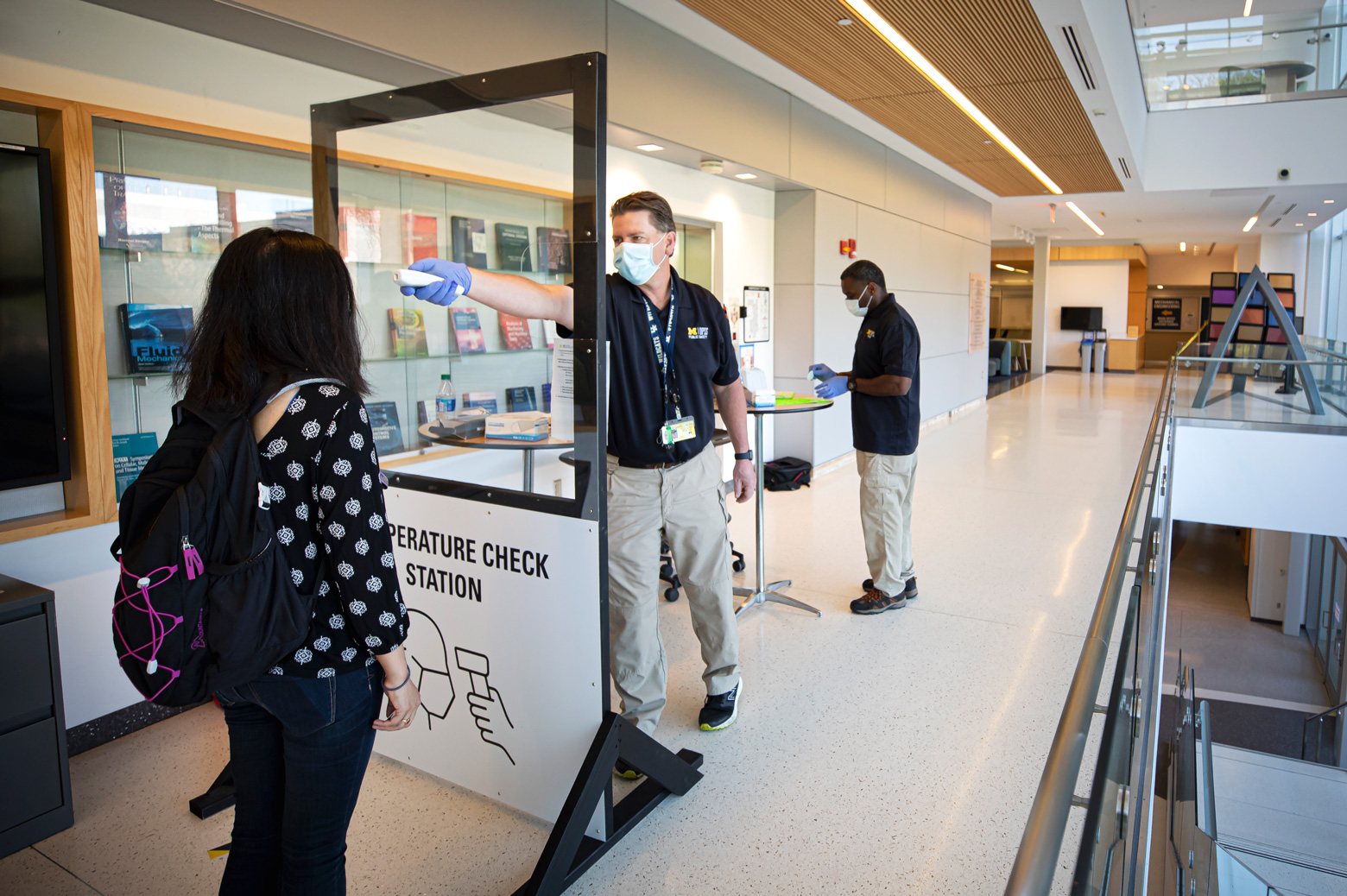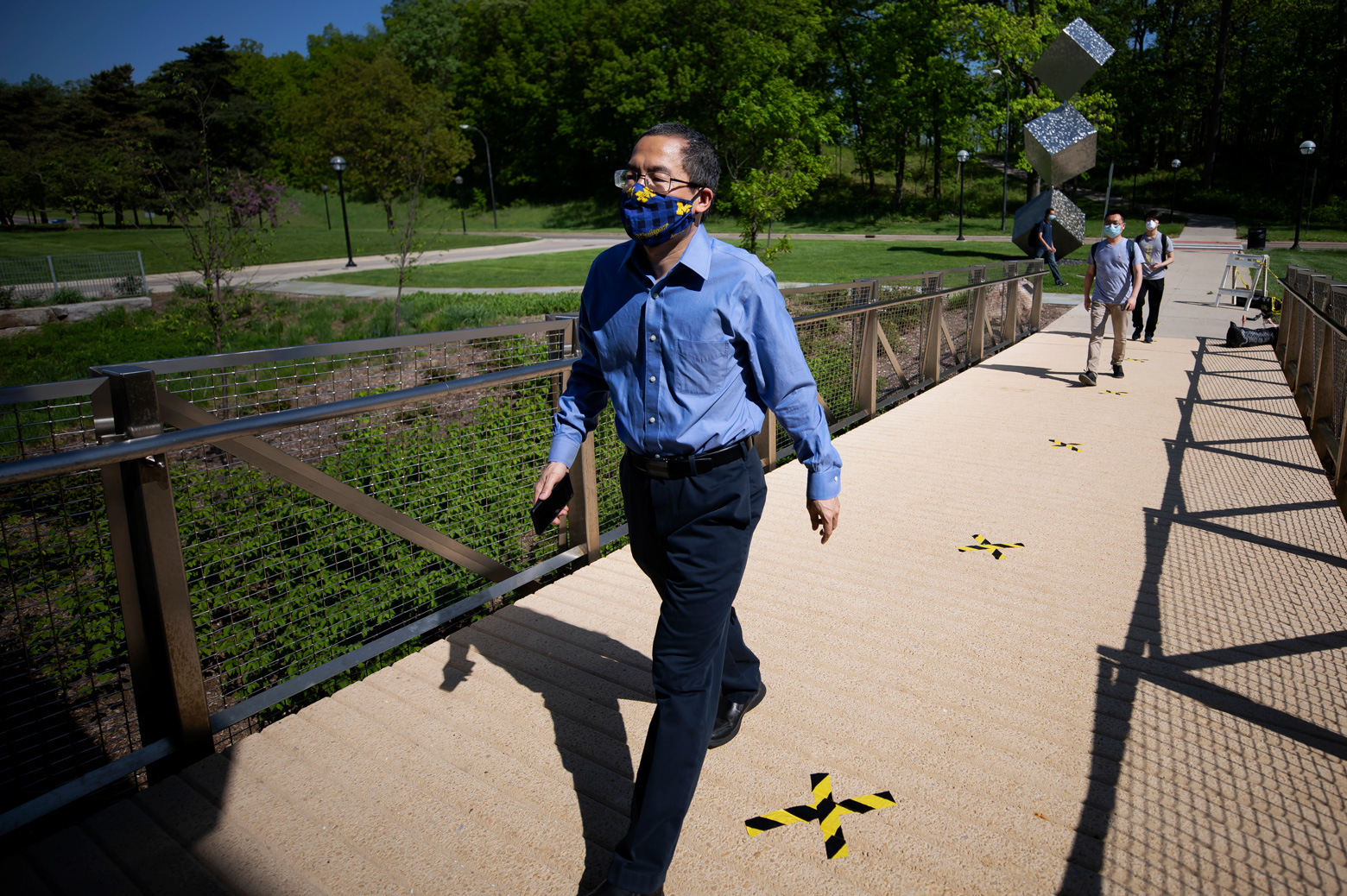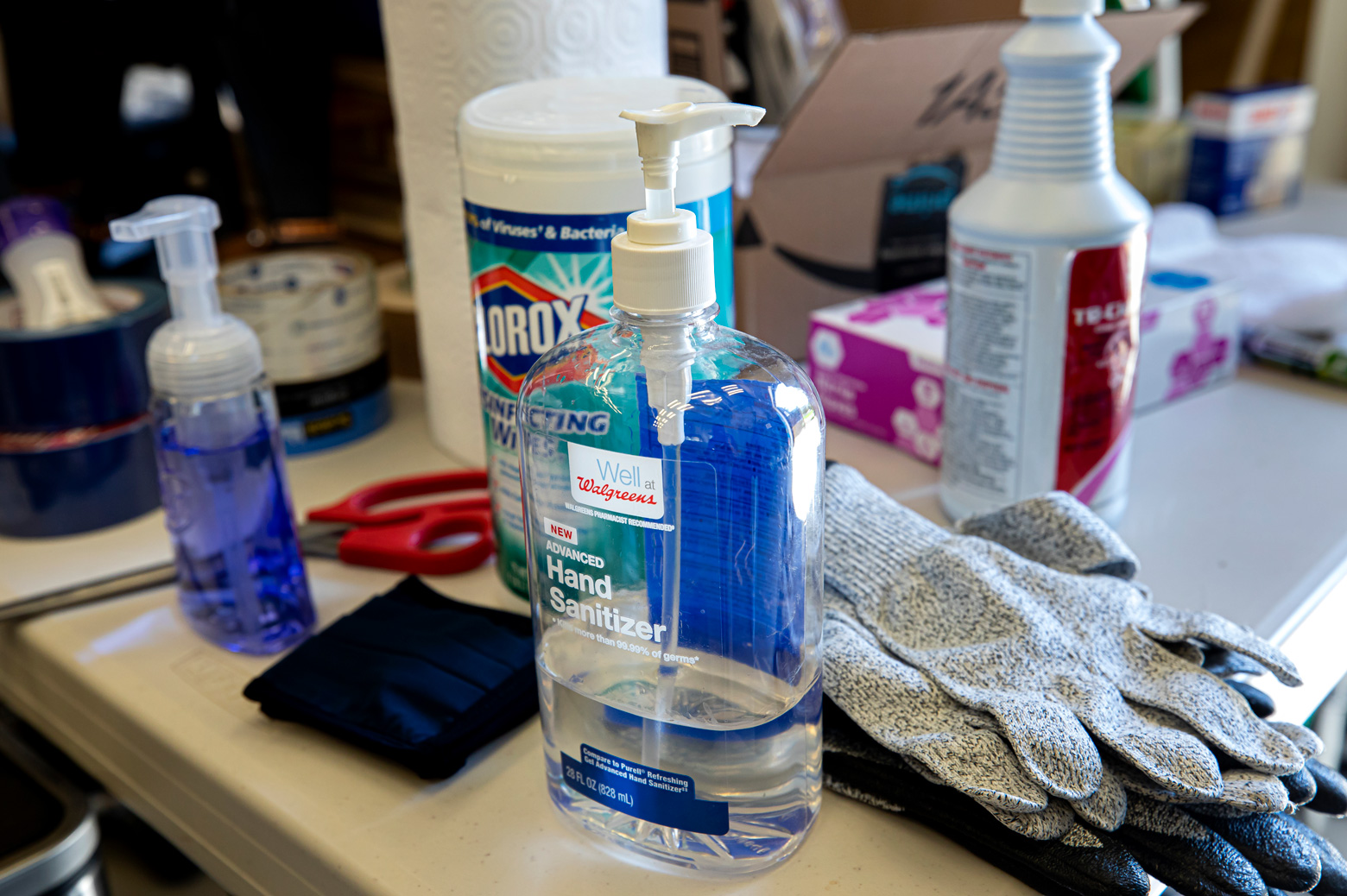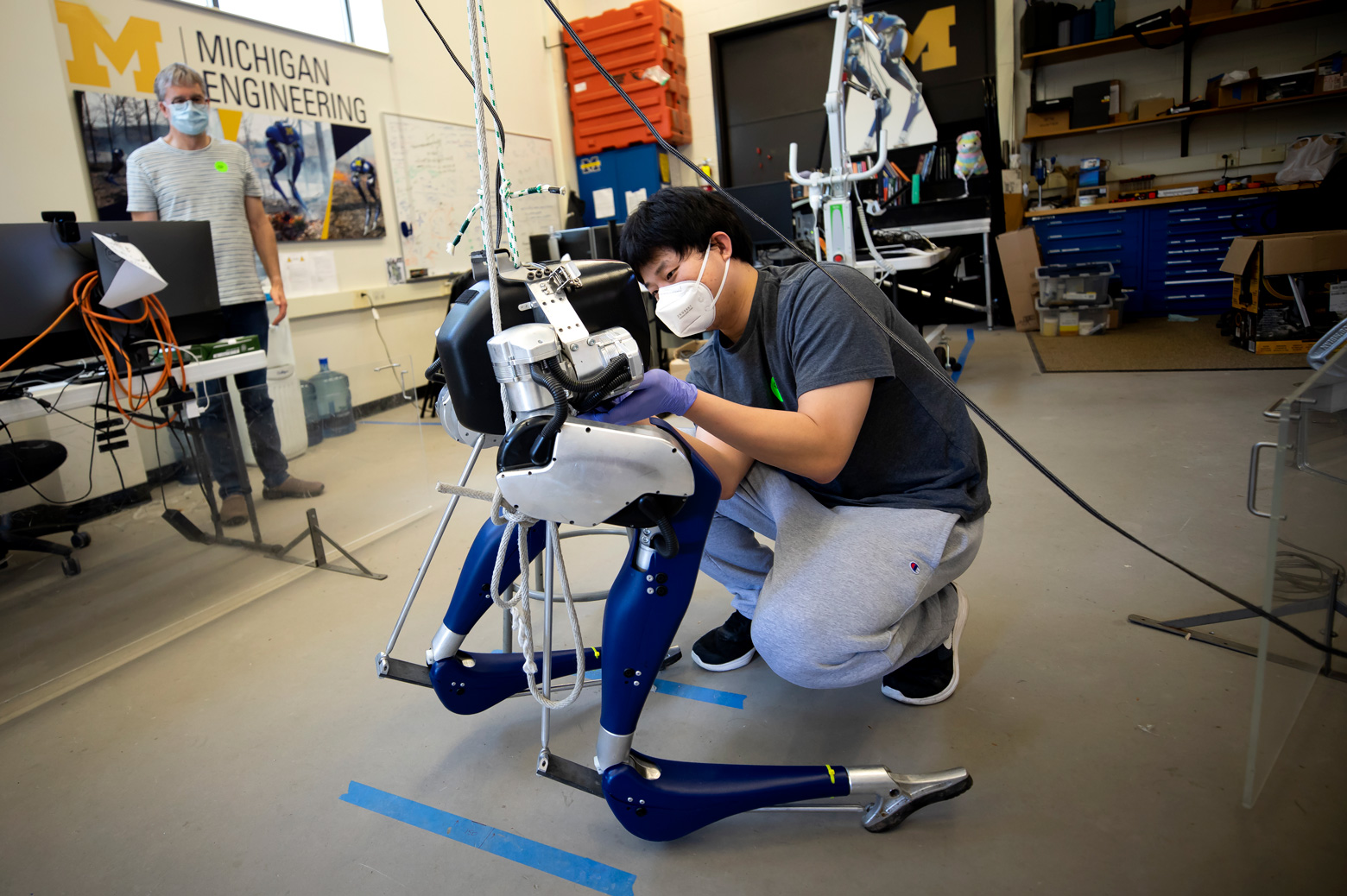Lights in the labs – and eyes – of researchers coming back to work
‘Noncritical’ in-person research begins ramping up, with public-health protocols.

 Enlarge
Enlarge
What does it mean for Michigan Engineering labs to reopen after COVID-19’s ten-week ramp-down?
Steve Forrest’s group can get back to printing heart cell arrays that could rapidly replace scarred tissue after a heart attack. Shilva Shrestha can gather the last bits of data for her dissertation on turning beer waste into a valuable feedstock for pharmaceuticals. Jessy Grizzle and his students have an extra spring in their step as they resume teaching their robot how to change its walking pace without falling over.
These are just a few examples from the first wave of faculty, staff and graduate students green-lighted to go back to work last week after the pandemic led U-M to suspend noncritical in-person lab research March 20. For more than two months, they had hunkered, working from home in an effort to flatten the curve.
Many aspects of their research, they were still able to do: write manuscripts, conduct simulations and meet remotely, for example. But key pieces were on pause.
“There’s a whole bunch of people that are thrilled to be in the lab again and a whole bunch of others who can’t wait to go back,” said Grizzle, director of the U-M Robotics Institute, the Elmer G. Gilbert Distinguished University Professor of Engineering, the Jerry W. and Carol L. Levin Professor of Engineering and a professor of electrical and computer engineering and mechanical engineering.
“And there are others who are anxious about returning and are good with working remotely. I’m proud of all of them.”

 Enlarge
Enlarge
U-M began ramping back up in phases last week after Gov. Gretchen Whitmer’s announcement that in-person lab research could resume with strict limitations based on public health guidance. Now, anyone entering a building must pass a health screening that involves a temperature check and a series of questions. Once inside, they must wear masks, disinfect high-touch surfaces in labs multiple times a day, and stay six feet from others, among other precautions.
Forrest came up with some strategies to help his group follow them, and make the most out of the Optoelectronic Components and Materials Group being together again in three dimensions. To make sure everyone keeps their distance, he marked boundaries with strips of tape on the ground. And he’s thinking of buying a couple megaphones because with all the lab noise and now with the face masks, it can be hard to have conversations at such distances.
“One of the things that’s probably not as appreciated is how important it is for people to meet each other in the lab. A lot of ideas are exchanged. A lot of talk goes on. That was constricted during the ramp-down, and it continues to be even now. It can get so loud in our labs with all the equipment and air conditioning,” said Forrest, the Peter A. Franken Distinguished University Professor of Engineering, the Paul G. Goebel Professor of Engineering and a professor of electrical and computer engineering, materials science and engineering and physics.

 Enlarge
Enlarge
Across campus, researchers spent time the first days back preparing to follow the new protocols. Shrestha and her colleagues in the Environmental Biotechnology Group developed a system to remind everyone to disinfect all equipment and working spaces before, during, and after their shifts. They printed signs with QR codes that link to a Google form where they can confirm they’ve done the steps.
They also put some instruments in storage to make sure everyone had enough space. Then she was able to get back to her experiments. She’s developing technologies that use beer waste from breweries and uneaten food from restaurants and university cafeterias to produce caproic acid, a valuable chemical used as building blocks for food additives, personal care products, cosmetics, and industrial lubricants. She hopes to defend this fall, and is glad to be able to go back to campus to gather her final data.
“A few days before I went in I was a little bit nervous,” said Shrestha, a doctoral student in civil and environmental engineering. “It felt like I’d be going to unfamiliar territory. But once I was back in the lab it felt like everything was normal.”
In the Biped Robotics Lab, researchers also welcomed the move toward normalcy.
“It’s exhilarating to be back,” Grizzle said. “You can see that the students and I all have an extra hitch in our step. To see someone in flesh and blood even six feet away is still better than a Zoom connection.”

 Enlarge
Enlarge
Among their first orders of business is for electrical and computer engineering Ph.D. student Omar Harib to test, on the two-legged Cassie robot, the adage that simulations are doomed to succeed, Grizzle said.
“Simulations often mislead you into thinking your approach is really good, but you don’t know until you actually do the experiments. Omar has some neat ideas about how Cassie can transition smoothly and stably amongst different walking speeds and now that we’re on campus we can make sure they work in real life.”
Innovations will be back in action in Forrest’s lab too. For two years, researchers there had been trying to employ his “organic vapor jet printing” technique, which is currently used to make OLED displays for TVs, and use it to produce arrays of beating heart cells. They could potentially be used to patch scarred muscle after a heart attack.

 Enlarge
Enlarge
“After many hiccups and back sliding, just before the labs closed, we figured out a way to attach the cells to a scaffold exactly how we wanted them to in high yield,” said Forrest. “We know the chemistry works. Now we just have to print them.”
Until the pandemic, his labs had never missed a day in 35 years.
“That doesn’t mean the machines were in use, but they were always up and running and ready. I’ve moved them from California to New Jersey and New Jersey to Ann Arbor but we’d do it in stages and we never lost time.
“And it was nice to see the lights go back on.”
Our campus, like the global community, is contending with COVID-19 and working to adapt to a new normal. Many are rapidly working on solutions. See all COVID-19 developments from Michigan Engineering.